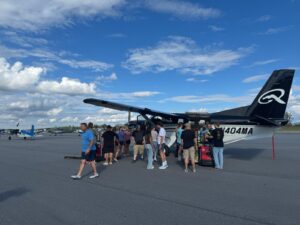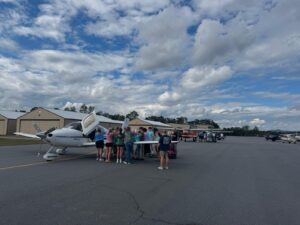Charter operators have become increasingly important in providing humanitarian aid across the globe. From delivering medical supplies to transporting emergency personnel, their flexibility and ability to access remote or conflict-ridden areas make them a crucial part of relief efforts.
“Business aviation participants typically get involved following exposure to involvement by friends or colleagues,” says chief strategy officer, Brad Pierce from AERObridge, an NBAA–endorsed group of experienced aviation specialists who coordinate emergency aviation response during disasters.
“In essence, people want to make a positive difference in the world. AERObridge provides a clear path to doing so by running a well-organized operation that enables volunteers to make a meaningful impact on day one of participating.”
Although every disaster is different regarding needs, some things are always immediately required when a crisis happens, says Charley Valera from AERObridge. “Pallets of water, easy-open canned food with high protein content such as tuna and peanut butter, warm or water-resistant clothing, and medical personnel, to name a few,” he says.

“Depending on the destruction and disaster, we acquire first aid kits, cleaning and paper products, bug spray, baby foods and supplies, pet supplies, communication equipment for airports, and provide relays. Everything needed is in bulk, weighed, marked, and loaded by ground crew volunteers onto the aircraft.”
Pierce says, “The aid AERObridge provides is extremely dynamic based on the needs of the affected area. Unlike traditional disaster recovery organizations, we have the flexibility to pivot at a moment’s notice.
“While food and hydration for life sustainment is typically an initial high priority, as additional aid reaches victims, their needs change. One example of such a change was during our Hurricane Ida activation.
“Roads were passable, but due to the considerable debris field from roof structure nails, victims were getting flat tires, which inhibited their ability to recover. We immediately began flying in tire repair kits so recipients had mobility, which was critical. This is the sort of flexibility needed to respond quickly to changing needs to provide the required critical aid where there may be a gap unfilled by other organizations.”
Preparation is key
In cases where it is possible, teams begin preparing for the incident in advance.
“We begin preparations as soon as possible, usually before the disaster strikes,” says Valera. “For instance, we will know days in advance about hurricanes.”
First and foremost, evaluating safety is paramount to ensure that any infrastructure challenges don’t pose risks to any volunteer pilots and ground crews.
“We usually have points of contact in the local police, fire departments, NGOs, and faith-based groups. We use various volunteers for a boots-on-the-ground approach for reliable intel on airfield conditions and who will be distributing the supplies down range once delivered. We study airport locations out of harm’s way as staging areas where the supplies will be initially loaded into aircraft. The aircraft deliver them to designated safe airfields where the supplies are unloaded and moved to the distribution areas,” Valera says.

“Once that baseline is established, an evaluation of suitable airfields, ground partner assets for receipt/distribution, and airspace considerations is conducted,” explains Pierce. “Technology also plays a key role. Satellite phones, communicators, and Starlink provide communications and intelligence in a damaged area that no longer has cellular connectivity.”
The right fit
Pierce explains that aircraft types needed during activations vary greatly depending on the particular needs and locale of the disaster area. “For instance, larger business aircraft can be highly effective at moving meaningful amounts of goods expeditiously in an area with long runways,” he says.
“Smaller aircraft are typically more suitable in areas with shorter runways or mountainous regions due to their ability to access these locations.
“Even float planes play a role in areas such as the Bahamas, where water landings are necessary to reach some victims. In essence, all types and sizes of aircraft play a vital role in providing disaster aid, with some being more suitable than others during a particular activation.
“AERObridge has a variety of volunteer assets available to best match the aircraft to the mission for maximum efficiency and effectiveness.”
When AERObridge activates in disaster response, the volunteers coordinate the donations or inbound passengers, such as doctors and nurses, with the aircraft entering the disaster airport and any outbound evacuees.
Marianne Stevenson, AERObridge founder and CEO says, “Each disaster is different, and we face challenges with this logistics bridge at the onset of each activation. Sometimes, the donations are not immediately available, and we need to work to procure them.
“Sometimes, when an area has been decimated, it takes rapid networking to create the channels to distribute the donations. These channels for distribution can be through faith-based groups, local law enforcement, or even grassroots community groups that emerge to aid their neighbors.
“AERObridge identifies these logistics points to ensure aid gets to the people who need it as rapidly as possible. We are more than just the transportation component of the logistics chain. We create the chain,” Stevenson says.

Risky business
Risk management always begins with evaluating the human factor and pairing missions appropriately.
“For example, an experienced high-time pilot might be best suited for a mission to a more challenging airport surrounded by terrain,” says Pierce. “A moderate-time recreational pilot would be better suited to fly to a flatland airport without obstructions. This is precisely the operational technique employed during the Hurricane Helene activation with a mix of terrain in North Carolina.”
Additionally, gathering operational intelligence such as runway conditions, weather challenges, airborne traffic congestion, and other relevant factors and sharing it with volunteer pilots ensures they can launch a mission with a better focus on managing risks.
“There is also a traffic deconfliction process, so aircraft are dispatched in an orderly manner, ensuring we don’t over-saturate the airspace,” continues Pierce.
“A North Star of importance for every mission is safety, which is paramount above all else to ensure everyone comes home without incident during activations.”
Every activation is different
During a mission for Hurricane Katrina, AERObridge transported 26 TSA agents from Florida to open the New Orleans airport to resume commercial flights. “These agents were essential, and their transport had an exponential effect on the relief efforts in the area,” says Stevenson.
When the team was in Haiti, they carried surgical sterilization equipment into a hospital in Port au Prince, allowing many patients to have sterile instruments during surgery and prevent infections.
“Additionally, we had fuel from aircraft that we sumped to run the generators of a hospital for weeks to allow for patient care,” says Stevenson.
“Following Hurricane Dorian, we were informed of a dire emergency regarding the need for insulin. Miraculously, one of our Aerobridge leaders went to a pharmacy asking for help. An MD was overhearing the conversation and was able to get insulin while the pilots were back waiting at the airfield,” says Stevenson.
Pierce believes the response to Hurricane Helene was general aviation’s (GA’s) finest moment.
“It demonstrated the effectiveness of using light aircraft to provide critical humanitarian aid in an expedited manner,” he says.
“In this activation, GA wasn’t only the best way, it was the only way to provide relief to the road infrastructure destroyed. While AERObridge has conducted countless activations over the years, I believe this particular activation enlightened the general public and government officials, highlighting the critical role GA can play during disasters.

“As a result, I foresee a fundamental shift during future disasters where GA will be specifically called upon to participate, given the understanding of the operational assistance we can provide quickly.”
According to Pierce the best advocates for encouraging the business aviation community to get involved is through volunteers sharing their experiences participating in missions during activations.
“Social media posts, for instance, showcasing the good work that’s being accomplished has led to countless pilots and aircraft owners reaching out saying that they want to help too. I believe people desire to be a part of making a real difference in the world. They need to be exposed to an opportunity to do so.
“Ongoing outreach during non-activation times is also critical to continue building the team, so that when the call to action is made, there’s an extensive number of volunteers ready to answer affirmatively,” he says.
“When the skies turn dark, our volunteers run towards the darkness to provide hope and help to those in need. We work tirelessly to provide critical life sustainment aid, working with community partners to make a meaningful impact with response efforts.
“Then, once official resources arrive and viable ground routes resume, our volunteers fade into the darkness without fanfare, remaining vigilant and ready to activate at a moment’s notice when called upon to serve again,” says Valera.





